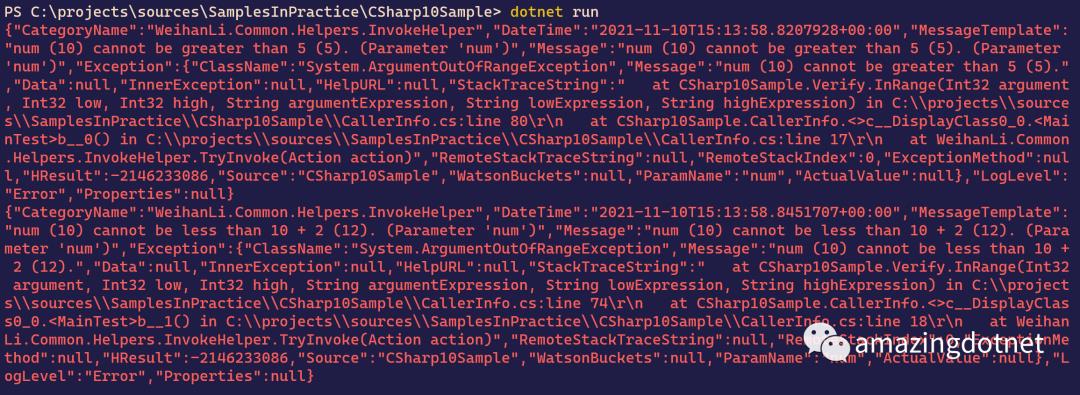C# 10 新特性 —— CallerArgumentExpression
Posted dotNET跨平台
tags:
篇首语:本文由小常识网(cha138.com)小编为大家整理,主要介绍了C# 10 新特性 —— CallerArgumentExpression相关的知识,希望对你有一定的参考价值。
C# 10 新特性 —— CallerArgumentExpression
Intro
C# 10 支持使用 CallerArgumentExpression 来自动地获取调用方的信息,这可以简化我们现在的一些代码,让代码更加简洁,一起看下面的示例吧
Caller Info
C# 在 5.0 的时候开始支持 Caller Info 自动获取调用方的一些信息,C# 5 开始支持的 Caller Info Attribute 有三个,
[
CallerMemberName] - 调用方成员名称,方法名或者属性名.[
CallerFilePath] - 调用方源代码所在文件路径[
CallerLineNumber] - 调用方所在源代码的行数信息
在方法参数中添加一个 Attribute 来获取调用方信息,使用示例如下:
public static void MainTest()
// 我是谁,我在哪儿
DumpCallerInfo();
private static void DumpCallerInfo(
[CallerFilePath] string? callerFilePath = null,
[CallerLineNumber] int? callerLineNumber = null,
[CallerMemberName] string? callerMemberName = null
)
Console.WriteLine("Caller info:");
Console.WriteLine($@"CallerFilePath: callerFilePath
CallerLineNumber: callerLineNumber
CallerMemberName: callerMemberName
");
针对 CallerLineNumber 的类型是 int,所以参数类型需要能够直接接收 int,如上面的 [CallerLineNumber] int? callerLineNumber = null 也可以改成 [CallerLineNumber] int callerLineNumber = -1 或者 [CallerLineNumber] long callerLineNumber = -1
但是不能改成 [CallerLineNumber] string callerLineNumber = null 或者 [CallerLineNumber] short callerLineNumber = -1
string 类型不兼容,short 不能隐式转换
上面代码输出结果类似下面:
Caller info:
CallerFilePath: C:\\projects\\sources\\SamplesInPractice\\CSharp10Sample\\CallerInfo.cs
CallerLineNumber: 8
CallerMemberName: MainTest
CallerArgumentExpression
CallerArgumentExpression 也是属于一种 Caller Info
下面这里是利用 CallerArgumentExpression 实现的几个验证方法,如果参数不合法就抛出一个异常,通过 CallerArgumenExpression 来自动的获取调用方的参数表达式
public static class Verify
public static void Argument(bool condition, string message, [CallerArgumentExpression("condition")] string? conditionExpression = null)
if (!condition) throw new ArgumentException(message: message, paramName: conditionExpression);
public static void NotNullOrEmpty(string argument, [CallerArgumentExpression("argument")] string? argumentExpression = null)
if (string.IsNullOrEmpty(argument))
throw new ArgumentException("Can not be null or empty", argumentExpression);
public static void InRange(int argument, int low, int high,
[CallerArgumentExpression("argument")] string? argumentExpression = null,
[CallerArgumentExpression("low")] string? lowExpression = null,
[CallerArgumentExpression("high")] string? highExpression = null)
if (argument < low)
throw new ArgumentOutOfRangeException(paramName: argumentExpression,
message: $"argumentExpression (argument) cannot be less than lowExpression (low).");
if (argument > high)
throw new ArgumentOutOfRangeException(paramName: argumentExpression,
message: $"argumentExpression (argument) cannot be greater than highExpression (high).");
public static void NotNull<T>(T? argument, [CallerArgumentExpression("argument")] string? argumentExpression = null)
where T : class
ArgumentNullException.ThrowIfNull(argument, argumentExpression);
来看一个使用调用示例:
var name = string.Empty;
InvokeHelper.TryInvoke(() => Verify.NotNullOrEmpty(name));上面的
InvokeHelper.TryInvoke是封装的一个方法,如果有异常会记录一个日志
上面代码执行结果如下:

可以看到我们的名称也是被记录了下来 Parameter 名字就是我们传入的变量名,不需要我们再手动的额外加一个 nameof(name) 了
再来看一个调用示例,调用代码如下:
var num = 10;
InvokeHelper.TryInvoke(() => Verify.InRange(num, 2, 5));
InvokeHelper.TryInvoke(() => Verify.InRange(num, 10 + 2, 10 + 5));输出结果如下:

如果没有变量名或者属性名等,就会直接用传入进来的 value 字面量,如果传入进来的是一个表达式,那么记录下来的就是表达式本身,比如上面输出的 5/10 + 2,而 num 是传入的一个变量,就会获取到变量的名字,是不是很神奇,很多验证的地方就可以简化很多了
Sample
CallerArgumentExpression 有一个很典型的一个实际应用就是 .NET 6 里新增的一个 API
ArgumentNullException.ThrowIfNull() 方法,这个方法的实现如下:
/// <summary>Throws an <see cref="ArgumentNullException"/> if <paramref name="argument"/> is null.</summary>
/// <param name="argument">The reference type argument to validate as non-null.</param>
/// <param name="paramName">The name of the parameter with which <paramref name="argument"/> corresponds.</param>
public static void ThrowIfNull([NotNull] object? argument, [CallerArgumentExpression("argument")] string? paramName = null)
if (argument is null)
Throw(paramName);
[DoesNotReturn]
private static void Throw(string? paramName) =>
throw new ArgumentNullException(paramName);源码可以从 Github 上看 https://github.com/dotnet/runtime/blob/v6.0.0/src/libraries/System.Private.CoreLib/src/System/ArgumentNullException.cs
我们实际调用的时候就可以不传参数名,会自动的获取参数名,示例如下:
object? xiaoMing = null;
InvokeHelper.TryInvoke(() => ArgumentNullException.ThrowIfNull(xiaoMing));输出结果如下:

从上面的结果我们可以看到,参数名已经自动的解析出来了
More
升级 .NET 6 的小伙伴快用这个改造你的代码吧,然后就是很多 null 检查也可以使用新的 ArgumentNullException.ThrowIfNull 去简化代码吧~~
想使用上述代码测试,可以从 Github 获取 https://github.com/WeihanLi/SamplesInPractice/blob/master/CSharp10Sample/CallerInfo.cs
References
https://www.codeproject.com/Tips/606379/Caller-Info-Attributes-in-Csharp-5-0
https://docs.microsoft.com/en-us/dotnet/csharp/language-reference/proposals/csharp-10.0/caller-argument-expression?WT.mc_id=DT-MVP-5004222
https://docs.microsoft.com/en-us/dotnet/csharp/language-reference/attributes/caller-information?WT.mc_id=DT-MVP-5004222
https://docs.microsoft.com/en-us/dotnet/csharp/whats-new/csharp-10?WT.mc_id=DT-MVP-5004222#callerargumentexpression-attribute-diagnostics
https://github.com/dotnet/runtime/blob/v6.0.0/src/libraries/System.Private.CoreLib/src/System/ArgumentNullException.cs
https://github.com/WeihanLi/SamplesInPractice/blob/master/CSharp10Sample/CallerInfo.cs
以上是关于C# 10 新特性 —— CallerArgumentExpression的主要内容,如果未能解决你的问题,请参考以下文章